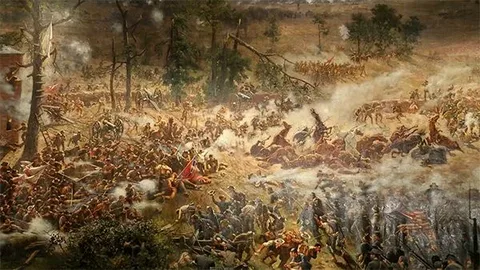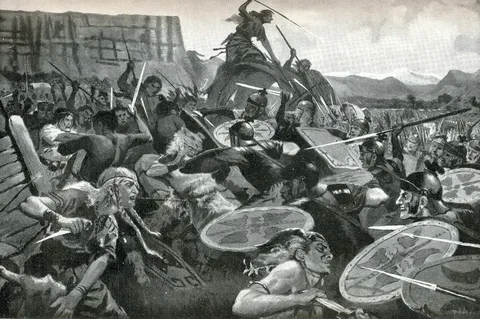The Battle of That Al-Reqaa’ in 4 Hijri is a pivotal moment in the early Islamic era, embodying the strategic acumen of Prophet Muhammad and the resilience of the fledgling Muslim community. Taking place in approximately 625 CE, this expedition reflects the balance between religious dedication, military strategy, and diplomacy that defined many early Islamic endeavors. Unlike many battles marked by intense clashes, the Battle of That Al-Reqaa’ was characterized by tactical maneuvers aimed at dispersing enemy forces and ensuring the security of Medina without extensive bloodshed.
The Battle of That Al-Reqaa’

In the early years after the migration to Medina, the Muslim community faced numerous threats from neighboring tribes that resented the emerging influence of Islam. Among these hostile groups, the Banu Ghatafan tribe was significant due to its size and strength. In the year 4 Hijri, intelligence reached Prophet Muhammad indicating that certain hostile tribes, including the Ghatafan and other Bedouin factions, were assembling near a location called Dhat al-Reqaa’ with the intention of launching attacks against Medina and disrupting the budding Muslim state.
The Prophet’s response was swift and decisive. Recognizing the danger these coalition forces posed, he organized an expedition to confront and ideally disperse these potential aggressors before they could initiate any violent actions. Such proactive measures were essential for the defense and consolidation of the Muslim community in its infancy, signaling to other tribes that aggression would not be tolerated.
Read about: The battle of Bani Qaenaqaa’ (2 Hijri).
The March and the Muslim Forces
The expeditionary force consisted of about 400 to 700 men, mostly seasoned fighters and companions of the Prophet. They embarked on a strategically planned march towards Dhat al-Reqaa’. The terrain was challenging, filled with desert expanses and rugged mountains, demanding endurance and careful navigation from the Muslim forces. The march itself tested the discipline and perseverance of the Muslims, who followed the Prophet’s guidance meticulously.
The destination, Dhat al-Reqaa’, was situated in an area predominantly controlled by the Ghatafan tribe. This made the expedition a direct message of deterrence to the hostile forces, asserting the capability and readiness of the Muslims to defend their territory. The choice to move swiftly and maintain order demonstrated astute military leadership that aimed not only to confront but also to intimidate and destabilize enemy alliances.
The Encounter and Tactics
Upon arrival, the Muslim forces found that the hostile tribes had chosen to avoid direct confrontation. The Ghatafan and their allies retreated to the surrounding mountains, seeking refuge and avoiding a battle they were unprepared to face at that moment. This retreat left behind their homes, women, and children, effectively ceding control of the area to the Muslims.
The Muslims exercised significant restraint once they occupied the enemy’s settlements. The capturing of some women and children, as documented by early Islamic sources, was a common wartime practice at the time and aimed at weakening enemy morale rather than inflicting unnecessary harm. Rather than pursuing the retreating tribes into the mountains, which would have risked ambush or prolonged skirmishes, the Muslim army consolidated their position, signaling the success of the operation.
This strategic approach emphasized minimizing violence while maximizing psychological and territorial control. It reflected the broader Islamic military ethos of avoiding unnecessary bloodshed unless absolutely required for defense or justice.
Read about: The battle of Bahran (3 Hijri).
The Service of Prayer of Danger
One of the most remarkable features of this expedition was how religious observance was maintained despite the ongoing military pressures. Prayer in Islam requires concentration and specific postures, making it challenging to perform during times of imminent threat. Prophet Muhammad innovated the “service of prayer of danger” (Salat al-Khawf) during this expedition, a system where the Muslim army was divided into groups. While one group prayed, the other stood guard, and then they would switch roles.
This arrangement ensured that spiritual needs were met without compromising safety, showcasing the flexibility of Islamic teachings when confronted with real-world challenges. The Quran addresses this situation in verses such as 4:101 and 5:11, which allow for the shortening of prayer times during conditions of fear and extreme danger.
This adaptability of religious practice underlines the practical wisdom that has guided Islamic law and ethics from its earliest days, balancing devotion with survival.
Recommend: The battle of Bani Al-Nadir (4 Hijri)
Aftermath and Diplomacy
Following the expedition, Prophet Muhammad engaged in negotiations with some of the tribes involved. These treaties were important for establishing peaceful relations and integrating various tribal factions into the growing Islamic state. This diplomatic approach was often favored over continued conflict, complementing military measures with negotiation to secure lasting stability.
The success at Dhat al-Reqaa’ also sent a clear message to surrounding tribes that the Muslim community was united, disciplined, and capable of swift response to threats. This deterrent effect was crucial in discouraging further coalitions against Medina and allowed the Muslims to consolidate power in the region.
Significance and Legacy
The Battle of That Al-Reqaa’ was a testament to the early Muslim community’s ability to innovate on the battlefield and maintain religious observance in difficult circumstances. It highlighted Prophet Muhammad’s strategic leadership, which combined military prudence with ethical considerations and spiritual flexibility.
The expedition also contributed to shaping the early Islamic state’s approach to security, warfare, and diplomacy. It demonstrated that Islam could accommodate the necessities of survival while maintaining its core principles, setting an important precedent for future Muslim leaders.
The name “Dhat al-Riqa'” itself carries symbolic meaning. It means “the one with patches or rags” and is believed to refer to the cloth strips Muslims wrapped around their feet during the arduous desert march. This image of endurance and determination encapsulates the spirit of the expedition and the broader early Islamic struggle.
FAQs
What triggered the Battle of That Al-Reqaa’?
Intelligence revealed hostile tribes, particularly the Banu Ghatafan, were gathering to attack Medina. Prophet Muhammad led the expedition to prevent this threat.
How did Muslims perform their prayers during the expedition?
The Prophet introduced the service of prayer of danger, dividing the army so some guarded while others prayed, ensuring safety without neglecting religious duties.
Was there heavy fighting during the expedition?
No, the enemy tribes mostly fled, avoiding direct confrontation. The Muslims focused on dispersing the gathering and securing the area.
What was the strategic importance of the expedition?
It served as a deterrent to hostile coalitions, reinforced the security of Medina, and showed the Muslim community’s capacity for swift and disciplined military action.
Why is the expedition called Dhat al-Riqa’?
The name likely refers to the cloth strips wrapped around the feet of Muslim soldiers during the march, symbolizing endurance through difficult terrain.
Conclusion
The Battle of That Al-Reqaa’ was far more than a military expedition; it was a foundational episode demonstrating how the young Muslim community navigated threats through a combination of faith, military strategy, and diplomacy. The expedition secured the safety of Medina by dispersing enemy forces without excessive violence, while introducing innovative practices like the prayer of danger to reconcile faith with the realities of war.
This balance of principles and pragmatism ensured the survival and strength of the Muslim community during a vulnerable period and laid the groundwork for future victories and the eventual expansion of Islam. The lessons of That Al-Reqaa’ continue to inspire reflections on leadership, resilience, and the integration of religion with practical life challenges.

